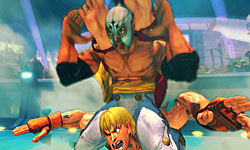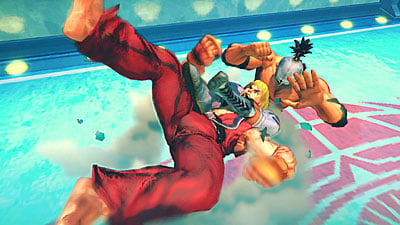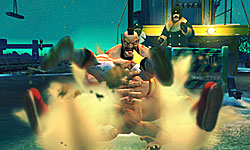Street Fighter II’s Spiritual Successor
August 1, 2008 – Without a doubt, the fan favorite in the Street Fighter lineage is Street Fighter II. It took the essential idea from its arcade father – having characters compete in a martial arts tournament – but added a larger roster of characters, fierce combos, tight controls, and those characteristic special moves that have been emulated (either in button press form or style) ever since it made its 1991 mark.

In fact, Street Fighter II was so popular that there were six editions of it. Why mess with your gaming golden egg and risk releasing a new, less popular sequel, when you can simply tweak the formula from time-to-time? And that’s the exact approach Capcom took. Those six editions – with amped-up titles like Hyper Street Fighter II and Super Street Fighter II Turbo – added everything from faster gameplay to super moves and even new characters, all while staying under the safety of the Street Fighter II umbrella.
Tougher times came when Capcom decided to strike out and head in the direction of true sequels. New entries like the Street Fighter Alpha and Street Fighter III series were good tiles in their own right (and still have solid fan bases), but they never achieved the notoriety of the Street Fighter II series (and let’s not give much play to the less-than-stellar 3D Street Fighter EX series). Poll gamers on their favorite entry and they’ll still say Street Fighter II (although they will fervently argue which particular edition is the best). So, why all the buildup about Street Fighter II? Well, Street Fighter IV looks like a return to form – it has the classic play of Street Fighter II mixed with a new artistic direction and great new fighting mechanics.

After so many Street Fighter editions and sequels, Capcom has learned that most gamers identify with the main roster of characters from Street Fighter II. So, Street Fighter IV features the original eight world warriors (Ryu, Ken, Blanka, Chun Li, E Honda, Guile, Zangief, and Dhalism), bosses like M. Bison and Sagat, and four newcomers: female, American spy Crimson Viper, French martial artist Abel, Mexican wrestler El Fuerte, and Rufus, an overweight Kung Fu master.
There’s a purist blessing for those that step up to Street Fighter IV for the first time: It plays almost exactly like Street Fighter II. You can still bust out hurricane kicks, hurl hadoukens, and chuck sonic booms across the screen using the same button combos from back in the day – muscle memory is a good thing this time around. Also, basic attacks are still mapped to three kick and punch buttons, and throwing is the same as in Street Fighter II (you just hold down punch and kick simultaneously).

Sure, that control set plays on the nostalgia factor, but this is a true sequel to Street Fighter II, not a remake (like the anticipated Super Street Fighter II Turbo HD Remix), so what makes the fighting engine unique this time around? First and foremost are Focus attacks (previously referred to as the Saving system). These attacks are performed by holding the two strong buttons and serve as a counterattack. The key with these attacks is timing – the longer you hold down the buttons, the higher the level of focus attack you perform. The first level focus attack won’t make you invulnerable, but it will allow you to score a quick hit. Hold the buttons down long enough, letting it charge to level three, and you’ll unleash a more powerful, unblockable attack.
The two other gameplay elements are Super and Ultra Combos. Super Combos should be familiar to fans of the series. Instead of giving each character multiple Super Combos (like in the Street Fighter Alpha series), Capcom is again turning to Street Fighter II; each character has one Super Combo they can perform once the appropriate meter fills.

While Super Combos are nice, Ultra Combos are where it’s at this time around. Performing them, however, is a little tricky. Each character has a revenge meter that fills as they take damage. Once the Revenge meter and Super Combo gauge are full, the character can unleash an Ultra Combo. These attacks pull the camera out of its static, side view position so that players can get a view of the multi-combo carnage. For example, Guile’s Revenge attack consists of a series of somersault kicks that sends his opponent flailing through the air.
Story-wise, Street Fighter IV is set between Street Fighter II and Street Fighter III. Capcom isn’t giving away much at this point from a narrative standpoint, but it has given some info on the presentation front. There will be animated prologues and endings for each character. Whether these will be done in the oil painting style of the original Street Fighter IV trailer or given a more traditional anime touch is still up in the air.
Aside from cutscenes, Capcom isn’t really ditching the classic story formula. In Street Fighter IV you’ll still fight warrior-after-warrior until to you get to a final boss. A blue, nearly naked muscle man named Seth takes the place of final bad guy this time out (sorry M. Bison; apparently you’re not evil enough anymore). Like many fighting game final bosses, he can use the abilities of other characters (like Dhalism’s stretchy limbs and Ken’s dragon punch), but also has his own attacks like an air vacuum that sucks you over from across the screen, allowing him to deal out a brutal combo.
The arcade build of the game runs at 60 FPS, but Capcom has not said whether the console port will match it or lock-in at a respectable rate of 30 FPS. However, knowing how Capcom aims for cross development (the arcade version is essential running on an upscale PC), it’s not a long shot to say the console and PC ports could be arcade perfect. Either way, the game looks beautiful. Characters have thick ink outlines that give them a painted look (much like Okami) and their individual animations are so over-the-top that they come off as cartoon-like.
Capcom is promising online play, but there aren’t a lot of details about it at the moment. Hopefully, they take the necessary time to iron out any bugs in the net code – just a few milliseconds of lag in a networked fighting game can spell doom for a game’s online lifespan.
A proper Street Fighter sequel has been a long time coming. Capcom seems to have struck a very nice balance: The classic gameplay of Street Fighter II is there and new elements – like Focus Attacks and the Revenge system – add some complexity to the game, while not feeling completely foreign or out of place. Fighting fans should have a lot to look forward to on their consoles when Street Fighter IV launches.
Game Features:
